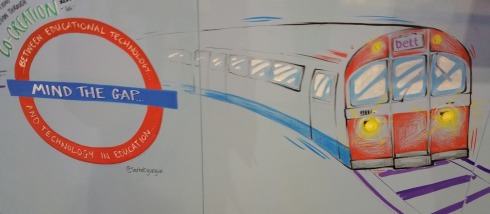On a recent trip to London, I had the opportunity to travel on the light rail and underground system. Every station had a “Mind the Gap” sign warning of the dangers when entering a train. As someone who experienced an actual fall through the gap on a train platform many years ago, I took some time to reflect on the analogous experience of students preparing for college. Students who are on a journey to and through college are like travelers entering trains to get to a final destination. They need a clear sense of direction and sure footing to reach their intended destination. If they’re unprepared, they may never understand the system to purchase a ticket or they might fall through the gap before entering the train. Having a disability that prevents them from gaining entry in the normal way is also a challenge. Once on the train, they find themselves pressed together with a diverse group of people and are sometimes hanging on tightly to stay safe. And getting off the train is just as difficult. The signs pointing in so many directions make it confusing to switch trains or find the right way out.

A current Teachers Guild challenge to find ways to support students on their journey to and through college caused me to reflect on my own journey. The story that I wrote, “Not Quite Good Enough,” is about the struggle that I had to be good enough for scholarship funding. Looking around at students today, I see the same struggles as they begin to feel beaten down by the challenge of getting grades and funding to gain entrance to college. Many succeed but others fall through the gaps because of the system of ranking students -a common practice in schools. They decide that their current circumstances are “good enough” and don’t pursue their passions beyond high school. The bar seems to be too high, the game too hard, for them to push on. They may have a destination in mind but no support and no practical way to get there.
How does this happen? If the feeling of “not good enough” doesn’t happen at home, reality hits when students walk through the school door for the first time. With good intentions, we test students to identify their strengths and weaknesses. What follows then is a practice of using the sorting hat to group students by ability and then assigning letter grades for each task that they complete. Students who start school behind are often unable to catch up because of the intense focus on achievement scores. Even students who are adept at navigating our grading system and are high scorers on college entrance exams are in for a big surprise when they reach their college of choice. Success in college depends on the ability to navigate a network of systems from social groups, to sessions with advisors, to part-time jobs in order to make it safely to the other side.
Educators in K-12 blame colleges and colleges toss the blame back to K-12. The reality is that we need to work together to help students find success in pursuing the college and career of their choice. And to do this, we have to begin exploring competency-based education and find new ways to measure student success. Colleges are also making changes. In fact, a Gartner prediction is that by 2020, up to 1/3 of colleges will support alternative ways to determine if students are college ready and will also have alternative ways of accessing student progress. The work that we do in K-12 is a driving force to change higher education.
I encourage each of you to get involved in the latest Teachers Guild challenge to answer the question,”How might we create programs, processes and tools to provide ongoing support to all students on their journey to and through college?” The current challenge is in partnership with the First Lady’s Reach Higher andBetter Make Room campaigns. Head over to the Teachers Guild, read some of the interviews and stories posted during the Discover phase, and take time to discuss the recurring themes with your colleagues. During the Ideate phase, you’ll have the opportunity to #reachwayhigher and post ideas, work with other guild members, and prototype solutions in your own school. I look forward to collaborating with you online!
No comments:
Post a Comment